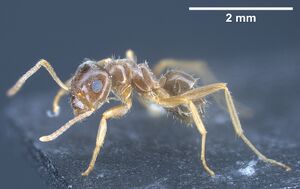Lasius brevipalpus
| Lasius brevipalpus | |
|---|---|

| |
| Scientific classification | |
| Kingdom: | Animalia |
| Phylum: | Arthropoda |
| Class: | Insecta |
| Order: | Hymenoptera |
| Family: | Formicidae |
| Subfamily: | Formicinae |
| Tribe: | Lasiini |
| Genus: | Lasius |
| Section: | niger clade |
| Species group: | unplaced |
| Species: | L. brevipalpus |
| Binomial name | |
| Lasius brevipalpus Seifert, 2020 | |
The type locality is a staggered array of very shallow sand dunes with very poor herb layer that change with rather humid Artemisia steppe in deeper parts of the area. Four samples were collected from sandy soil in humid parts of the site and one sample from a sand dune. (Seifert 2020)
Identification
Keys including this Species
Distribution
Known from the Kazakhstan type locality: 47°42′21″N 85°18′00″E / 47.7058°N 85.3000°E, 496m.
Distribution based on Regional Taxon Lists
Palaearctic Region: Kazakhstan (type locality).
Distribution based on AntMaps
Distribution based on AntWeb specimens
Check data from AntWeb
Countries Occupied
| Number of countries occupied by this species based on AntWiki Regional Taxon Lists. In general, fewer countries occupied indicates a narrower range, while more countries indicates a more widespread species. |

|
Biology
Castes
Worker
Images from AntWeb
   
| |
| Holotype of Lasius brevipalpus. Worker. Specimen code antweb1041434. Photographer Roland Schultz, uploaded by California Academy of Sciences. | Owned by SMNG, Görlitz, Germany. |
Nomenclature
The following information is derived from Barry Bolton's Online Catalogue of the Ants of the World.
- brevipalpus. Lasius brevipalpus Seifert, 2020: 57, figs. 31-32 (w.) KAZAKHSTAN.
Unless otherwise noted the text for the remainder of this section is reported from the publication that includes the original description.
Description
Small-sized (CS 812 µm). Large head and scape length indices are contrasted by a small palp length index (CL/ CW900 1.084, SL/CS900 1.004, MP6/CS900 0.153). Toruloclypeal distance and number of mandibular dents medium (dClAn900 4.46, MaDe900 8.53). Length of frontal pubescence hairs rather large (PLF900 32.1), clypeal pubescence dilute (sqPDCL900 4.99). Setae numbers on whole body small but pronotal setae long (nOcc900 9.0, nGen900 2.3, nGu900 2.3, nSc900 4.6, nHT900 6.2, PnHL/ CS900 0.162). Setae on dorsal plane of scape rather short, most of these protruding close to counting threshold of 20 µm which explains the variance of nSc counts. Coloration: whole body concolorous medium brown to light yellowish-brown; antennae, tibiae and tarsae pale yellowish brown. There is no species in Asia combining long scape, short terminal segment of maxillary palps, long pronotal setae and low gular setae numbers.
See table 3 in Seifert 2020 for additional morphometrics. The abbreviated names of various quantitative data shown above are defined here: Seifert 2020 Lasius characters.
Type Material
Holotype plus 5 paratype workers on three pins labelled ”KAZ: 47.42.21N, 85.00E 496 m, feucht-salzige Artemisia-Steppe leg, Seifert 2001.07.25 -81“, 12 paratype workers on four pins with the same locality label but sample No 73, 73b and 212; depository Staatliches Museum für Naturkunde Görlitz.
Etymology
The name refers to the short terminal segment of maxillary palp.
References
- Boudinot, B.E., Borowiec, M.L., Prebus, M.M. 2022. Phylogeny, evolution, and classification of the ant genus Lasius, the tribe Lasiini and the subfamily Formicinae (Hymenoptera: Formicidae). Systematic Entomology 47, 113-151 (doi:10.1111/syen.12522).
- Seifert, B. 2020. A taxonomic revision of the Palaearctic members of the subgenus Lasius s.str. (Hymenoptera, Formicidae). Soil Organisms 92(1): 15-86 (doi:10.25674/so92iss1pp15).

